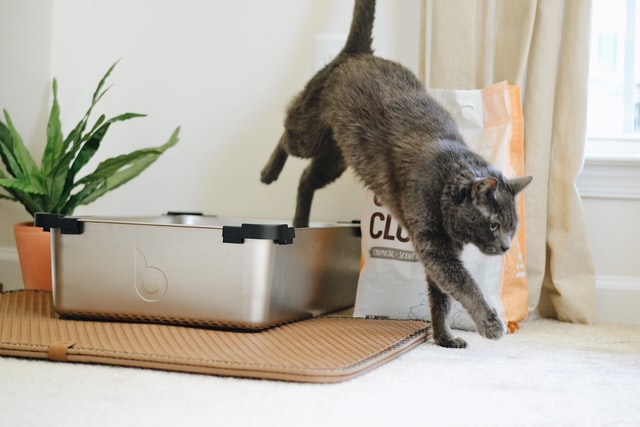When people adopt a puppy, one of the first things they do is train the puppy to go to the bathroom outside… understandably so! Litter box training is something that logically you’d also need to do then, right? Since most cats use a litter box indoors, you probably need to train them to figure out where the litter box is or they won’t figure it out.
Have no fear! I’ve created this extremely comprehensive guide on litter box training your cat. Hopefully you’ll get a few tips on what to do so you can keep your cat using their litter box consistently.
Steps To Litter Box Training
Thankfully, there are only a few steps to successful litter box training:
- Set up your adequately sized litter box in an appropriate location.
- Add a litter that is appealing to your cat.
- Your cat will begin using the box naturally and you don’t need to do anything else.
Wow, that was easy! And short.
Now, you may notice that there wasn’t much actual training involved in my litter box training guide. That’s because you generally don’t need to actually train your cat to use the litter box. According to Behavior Problems of the Dog and Cat by Gary Landsberg and colleagues, there isn’t really much to do to train your cat to use the litter box. In fact, they only have one paragraph devoted to litter box training. It can basically be summed up as, “Not needed. Set up your box correctly. Have a vet examine the cat if they’re not using the box.”

Why Don’t You Need To Litter Box Train Your Cat?
Why don’t cats need to be box trained? They typically come pre-trained. According to The Domestic Cat: The Biology of its Behaviour by Dennis Turner and Patrick Bateson, all training comes from the cat’s mother when they are kittens: For the first few weeks of life, kittens rely on their mothers to stimulate them to go to the bathroom. As they mature, their mother teaches them how to find where to go to the bathroom and their instinct takes over.
Cats will naturally seek out a place to go to the bathroom that meets their preferences when they’re ready to go again. While litter box usage is complex, there are some general things you can try instead of litter box training to help your cat choose to use the litter box.
The Problem May Be The Litter Box Set Up
Each cat has their preferences so it’s important to listen to your cat, but they generally like litter boxes that are safe, quiet, and big enough to turn around in. Covered boxes are a mixed bag, but you’re generally better off without a cover.
Many commercial litter boxes are actually too small for the average cat. If you’re looking for a great option to get a litter box your cat likes, I personally use a DIY litter box made out of a storage tub.
For litter, a small granule litter that the cat can easily bury their waste in is best. There are various preferences for types of litter based on early experiences, genetics, and even things like if the cat is declawed. However, an unscented litter is the best choice as cats have more sensitive senses of smell than us. Plus, most scented litters end up smelling worse once your cat has used them. Skip the scent and keep your litter box well maintained instead.
You’ll also want to clean out the box regularly. Scooping daily (yes, daily) will keep the box clean and not smelling like, well, a litter box. If you struggle to scoop regularly, I suggest discovering the magic of the Litter Genie to make it easy and convenient to scoop the box. Replace the litter weekly and do a more thorough clean using a gentle detergent (not bleach) once per month. Your cat and nose will thank you.
(Don’t) Show Them the Box
Now that you know the basics of how to set up a good litter box, sounds like cats should be able to find the box just fine without any litter box training, right? If you’re still feeling like you need to do something to help your cat find the box, you may fall victim to a common cat behavior myth I hear frequently. There’s an idea that you need to “show” your cat the box in order for them to find the box. The idea is that you take the cat around and either let them see where their litter box or boxes are or even place the cat in the box.
If you’re feeling lazy, I have some good news: You can safely skip showing your cat the litter box. In fact, you should skip putting your cat in the litter box. Let me explain.

Cats will naturally seek out places that are appealing to them to go to the bathroom. When they get the urge to go, they’ll seek somewhere out and find their way to the box. This may be a combination of memory or scent. When you bring a cat home, the best step you can take is to keep them in a single room for a few days as a transition with all their basic needs including (wait for it) a litter box. Unless the room is huge or the box is inaccessible, they’ll find the box.
After that, you can gradually introduce the cat to other parts of the house. It’s once again best to do that slowly so the cat really shouldn’t ever be far from a box. By the time they need to go, they’ll have had time to figure out where any additional boxes are.
I hope this is obvious, but if your cat has normal bowel and bladder functioning they’ll be okay “holding it” for a bit until they get to the box. If they’re not going in the litter box, there’s likely a medical issue going on, something is wrong with your box set up, or there’s a behavioral problem that “showing them” the box won’t help with, nor will any amount of litter box training.
You May Create A Problem
Speaking of which, showing your cat the box can create problems with box usage. If you have a new cat and they are anxious about being in a new environment, showing them the box may create a negative association with the box. If a strange human picks them up and places them in the box, the cat may make an association with the box and the fear and not end up using it. Heck, even if you know the cat, being in a new environment can be extremely stressful for the cat and the added stress of being picked up and placed in the box may be too stressful for them to handle.
You might create the problem you are trying to avoid!
Yes, that may not make sense to us humans, but cats think differently than we do. It doesn’t matter if it makes sense to us… It’s the cats’ perception that matters.
And again, it’s completely unnecessary to show your cat the box. You aren’t gaining anything by showing your cat the box. They’ll probably just end up confused and if your cat isn’t using their litter box, it’s not because they don’t know where it is.
Skip Deterrents
Similar to not showing your cat where the litter box is, suggestions for litter box training sometimes include use of deterrents like spikes or remote punishment devices in places you don’t want your cat to go or to correct a litter box problem. I’m here to tell you that even though putting your cat into the box is not a good idea, these methods are even worse. First, they’ll make your cat stressed and stressed cats can have all sorts of behavior problems.
Second, they’ll likely just cause your cat to move to a different location. That location may not be the litter box and you’ll just have more cat pee to clean. Focus on meeting your cat’s needs and making it easy for them to choose to use the litter box. You’ll be much more successful.
Is Training Ever Necessary?
So… is it ever necessary to train a cat to use the box?
Because cats are complicated, the answer is “rarely, but sometimes.”
In situations where a cat may not have been properly trained by their mothers, you may need to help the cat with a bit of training. These aren’t common situations, however. Unless you’re certain your cat didn’t get trained by their mother, you’re likely wasting your time trying to do actual training. You may also need to help a kitten out if they are orphaned, but that isn’t something that applies to most people.
If your cat isn’t using the box, the first thing you should do is get medical causes ruled out by your veterinarian. You can also try something easy like mixing in Dr. Elsey’s Cat Attract to your litter to see if that helps.
If neither of those interventions work, the next step is working with a cat behaviorist with expertise in litter boxes like myself to figure out what’s going on. In many cases, there is an issue with the environment or you may use the wrong litter. A behavior consultation will be able to help you figure out what exactly is going on with your cat and give you a personalized plan that will be more effective than attempting litter box training.
And for the love of all things furry, don’t try putting your cat into the box.










